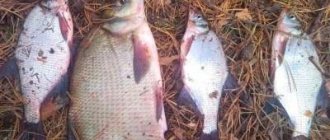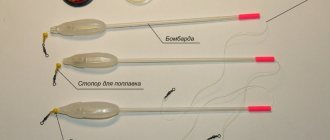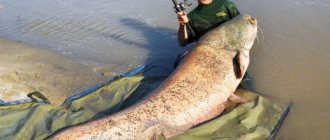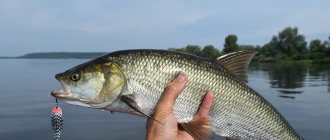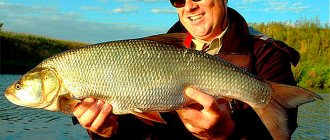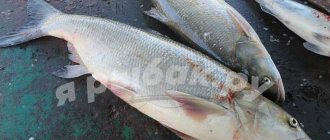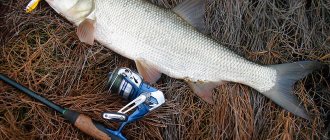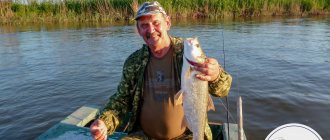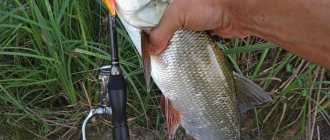Buy quality products at affordable prices in the best fishing online stores
. Give gifts to yourself and your loved ones!
we are in social networks
— subscribe to us on Facebook, Youtube, VKontakte and Instagram. Stay up to date with the latest site news.
The most successful time for asp fishing is considered to be the second half of spring. April ends, and the asp begins to feel hungry. After spawning, it eats everything that comes in its way. Even if you have never purposefully fished for asp, you will still have a good chance of catching a couple of good tails. True, this does not mean that you can not prepare for fishing at all and fish anywhere, and the asp will sit on the hook itself.
What does an asp like?
Asp, also called sheresper, loves fast flowing water . The fry and bleak eat with pleasure . It does not hesitate to eat other small fish that live near the surface of the water. Its diet includes insects (for example, dragonflies, butterflies, etc.).
Insect larvae are also the asp’s favorite “dish”.
In autumn, among other things, the sheresper feeds on frogs, which at this time find themselves in rivers.
Asp is a schooling fish . Sometimes a group of hunting fish consists of more than 50 individuals . It creates a lot of splashes. Seagulls often circle above it, looking for their prey.
But usually the hunting of a sheresper is less noticeable : a group of several individuals (for example, 5 asps) selects a stream and passes along it in the direction of the water flow, occasionally creating splashes , and then returns and descends again along the stream, collecting prey in its large mouths.
Asps are daytime hunters . At night they look for something to eat only when it is very hot during the day. As a rule, sherespers hunt close to the surface of a reservoir , but in the spring they drop lower (at this time they can even be caught with bottom tackle). This fish is particularly voracious, so the average weight of an adult is approximately 10 kg .
What bait should I use for asp?
A silver-colored floating wobbler, which is so similar to bleak, becomes the best bait for asp in the spring. First of all, of course, such baits have good performance due to their external similarity. Such wobblers rise to the surface and float with the current; they can be directed to snags where fry often hide and there is a possibility of a predatory asp appearing. A compound crankbait (such as a Jointed Rapala) can help imitate a wounded fry. Such a fry can be very attractive to an asp, as it is a very easy prey. Perhaps the most interesting part of spring fishing is fishing with poppers and surface stickbaits. Asp begins to respond to these baits earlier than other fish species; in this case, they can be used as early as April. If the fish has lost interest in the bait (which happens often, because the asp is quite smart), then it is necessary to change it and change the wiring diagram. At night, you can use luminous baits.
Bite in spring
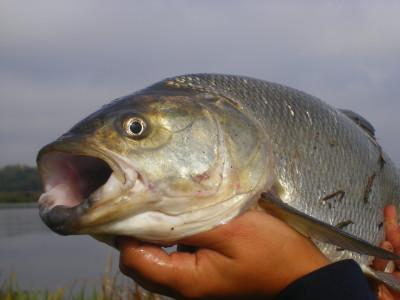
The best time to catch asp is the peak of the flood, when melt water fills the shallow waters. This is approximately mid-April.
The peak of the flood may occur at other times (it all depends on the temperature conditions of the region).
As soon as the ice has melted, you can track the asp using a spinning rod. You should look for it at a sufficient depth (about 50 meters from the shore); this fish does not like shallow water .
When should you go asp fishing?
Many fishermen are interested in what months they need to fish in order to catch an asp. At the end of April - beginning of May, the asp begins to spawn. At this moment the biting practically stops. Most fishermen do not go fishing at this time of year. It is best to catch asp before and after spawning . The best bite begins in the last spring month, approximately in its middle, since by that time the fish are weakened after winter and spawning. The asp is very hungry and can be caught even with a simple fishing rod using bloodworms. After a period of 7 to 10 days, the asp fully recovers its strength and returns to its most favorite habitats and hunting areas.
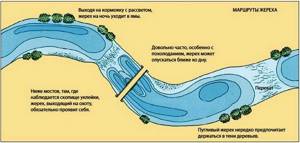
We equip the spinning rod
If a spinning rod is needed for fishing from a boat, its optimal length is 2.5 meters . If from the shore - a little more than 3 meters . This length will ensure correct casts.
Choosing a rod
The spinning rod should have a fairly long and, most importantly, flexible rod . A rigid rod can play a negative role: the sheresper has fragile jaws that easily tear with a strong jerk.
If asp hunting is carried out where there are thickets (bush, etc.), it is better to take a short rod: it is more convenient with it in such conditions. For example, Avid produced by St. Croix . It is 7 feet long, that is, 2.14 meters . If there is no interference, use a longer rod, 2.59 meters .
A good choice is Shimano Trout One. With this rod you can cast baits without much difficulty and with ease.
Coil selection
The reel is an important device , without which the spinning rod will not function.
The choice of reel largely depends on the fishing method and directly on the rod.
Now there is a huge selection on the market, but many fishermen claim that the Shimano Tween Power 2500 FA reel has proven itself in the business.
What you need to know about fishing line
asp using braided fishing line , as it does not stretch, resulting in the bait breaking, the hook unbending and large specimens of sheresper falling off. The attack of the bait by the asp is rapid, the friction brake does not always react in time, the fishing line breaks upon impact .
In addition, the braided line does not lie tightly on the spool, throwing off the loops.
All these troubles can be avoided by using monofilament (monofilament) . It is practically invisible in the water; it tends to stretch when the fish grabs the bait, and binds the asp in the process of landing. If the friction brake is adjusted correctly, no large sheresper will be able to cope with a monofilament line 0.22 millimeters in diameter . Of course, he will pull 10 meters of fishing line from the reel, and that’s it, then it’s yours.
Leashes
Not all anglers use leashes to catch asp. However, leaders make fishing more efficient .
You can make the leash yourself from steel wire (the twist will be strong, but not plastic), or you can buy synthetic kevral in the store. It is also durable, but, on the downside, it is opaque . Monofilament fishing line has proven itself to be excellent as a leash .
Spinning rod equipment for asp fishing in spring
If we fish from a boat, we will use a spinning rod 2.1-2.4 m long with a dough of up to 50 grams. It can be a heavyweight or an extra heavyweight. When fishing with heavy spoons, we use the second option, and when fishing with wobblers and jig baits, we use a heavyweight with a moderately hard action.
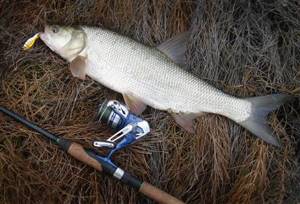
On the rod we place a power, traction reel with a spool capacity of 2000 to 3000. We wind a line with a cross-section of 0.25 mm or braid with a diameter of 0.12-0.16 mm on it. The breaking load of the cords is within 6-8 kg. We do not use a leash, since using it significantly reduces the number of asp bites.
Lures. What is the significance of their color?
Sheresper quickly gets used to the bait and stops responding to it. Therefore, the “victim” of the asp should be changed frequently. Or at least change the tactics and direction of its conduct.
The bait is attached to the fishing line either with a clasp or a knot (Rapala knot). The clasp allows you to quickly change the bait. A surface bait is secured to the fishing line with a clinch.
As for the color of the “prey,” the asp willingly pursues silver-colored objects . This is exactly the color of the sheresper’s favorite food - bleak. The asp bites well on azure-colored bait if the day is cloudless. Her sides should be silver . Before sunset, it is better to tie a bait with golden sides and an orange top. When it is cloudy, the dark back of the “prey” and its silvery sides will certainly attract the attention of the sheresper.
It’s getting dark - choose fluorescent colors to attract the asp’s attention.
Wobbler
A decent option would be:
- Original Rapala (9 cm),
- Jointed Rapala (7 cm, for slow retrieve),
- Countdown (7 cm, fast wiring),
- Team Esco.
A wobbler is a very good bait option for catching asp near the shore. Outwardly, it resembles the food familiar to sherespers: the bait can float. Even very cunning fish get hooked, seduced by the “victim”. The bait helps out the fisherman if the shore is open and there is nothing to hide behind: the wobbler can be sent to float with the flow , being at a certain distance from the places where the sheresper exits were noticed.
A tree lying in the water or branches hanging low above the water are not a hindrance for the wobbler
Spinner (rotating spoon)
A bait that is already considered a classic . Accuracy and casting distance directly depend on the weight of the spoon. The larger it is, the more accurate the casts.
In this case, the fishing line should not be thick , and the petal should play well. There are few models of such turntables. Let's name some of them:
- Myran spinners ,
- Smith Niakis turntables ,
- 17 gram Daiwa Silver Greek in the shape of silver fish.
Spinner-spoon
The bait is a small oscillating spoon . For example, River Old - it is very attractive to asp, because it has a phosphoricidal color.
Cicada
Few fishermen know about this bait. It is completely metal, weighs from 7 to 14 grams . During the migration, the cicada creates noise that attracts the attention of the sheresper.
Withstands a fairly high wiring speed - 10 kilometers per hour .
Streamer
The streamer, which has long been known to anglers, is used for fly fishing for asp . This is a hook to which a feather is attached (maybe fur). The wings of the bait should be longer than the hook. In water, a streamer behaves similarly to a fry . 5 centimeters long , but even very large fish bite well on it.
Jig
Jig has recently appeared among lures. Its goal is to imitate both the external characteristics and the smell of an asp victim. The nozzle is made of plastic, adding flavors that are pleasant to the fish.
There are active and passive jigs . The latter are rare. Active ones, in turn, can be divided into vibrating tails and twisters (they will be discussed below).
Popper
A popper is a surface wobbler . Fishing with such bait is very spectacular, but it is worth remembering that this bait is used at certain times of the year. For example, perches bite on it in early summer. And in April - the beginning of catching asp with this bait.
The popper moves along the water surface , and the sheresper attacks it, forming a whirlpool. A hooked asp, trying to free himself, often jumps out of the water and, plunging back, raises splashes.
Castmaster
Manufacturer: American company Acme Tackle .
In appearance, Kastmaster is an obliquely cut cylinder . Americans catch bass with it. Our asp also bites well on this bait.
Spinnerbait
This type of bait is over 100 years old . It was invented in America. Bate is bait, spinner is rotating. It is a small angle made of wire with rotating petals (or petal) at the top and a lead head at the bottom. The hook of the bait is fringed with rubber, reminiscent of octopus tentacles. Instead of fringe there can be an artificial fish .
The asp senses vibrations, hears sound, reacts to color and cannot be indifferent to strange prey and attacks it. With the help of a spinnerbait, sheresper can be caught in thickets : the bait is perfectly passable thanks to the rotation of the spoon, which pushes apart the algae, and all the spinnerbait’s designs.
Vabik
Wabiki are bundles of feathers , tinsel or nylon threads. Typically, fishermen use wabik to stimulate the hunter's instinct in the asp. A predator, seeing another predator, which seems to be a wabik, begins to hunt more actively and swallows another bait (a spoon, for example). Sheresper often tries to remove the “competitor”. During wiring, the wabiki are optically blurred, causing a grasping reflex in the asp.
Tackle for asp fishing
In spring, spinning fishing is most popular. But since in most regions there is a spawning ban, we will not dwell only on spinning rods, and will also consider fishing with a float.
Spinning
Catching asp involves very precise casting, so you can forget about the average and even slower action of the blank.
The rod should only have a fast or super-fast action!
If everything is clear with the system, then with the test everything is not so clear. Thus, at the beginning of spring, light baits, and therefore a small test of up to 15 grams, will be appropriate. After spawning, you should think about a heavier rod with a test weight from 15 to 30, and sometimes more, depending on the size of the reservoir.
When fishing before spawning, it is better to take a reel with a small spool up to 2500. Since long casting is not required, caked line will not prevent you from casting to the desired place. The main thing here is the elegance and harmony of the gear.
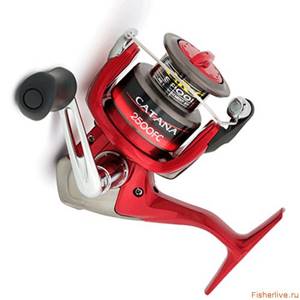
After spawning, you should use more serious gear, including a reel with a spool size of 3000 or more. Such a reel holds enough line, and thanks to the large size of the spool, the line does not curl into the spring so much, which has a beneficial effect on casting distance.
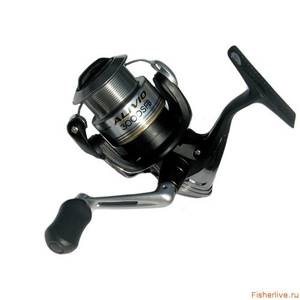
It is better to use monofilament as fishing line. The asp's bite is very aggressive, and it is difficult to miss it even at a great distance. It is better to avoid using braid, as it greatly damages the rod guides. Catching a 5-7 kg asp is not uncommon, and such a weight combined with braiding will kill even the best quality rings in a week.
In the spring, you can catch asp with various baits, but they must be divided into before and after spawning. Before spawning, when long casting is not required, anglers use floating wobblers that imitate bleak. Also at this time, spinners of silver colors of the “long” class, and other baits except deep ones, work well.
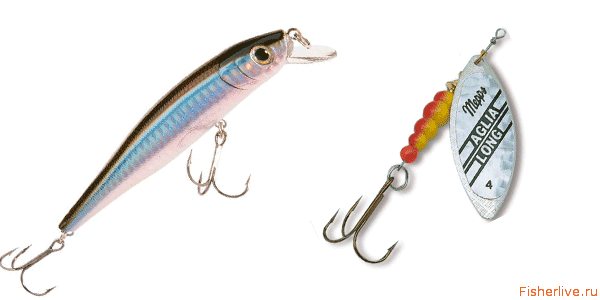
After spawning, you need to use long-range and accurate baits. These will be the well-known “castmaster” and the classic asp bait “three-edge”.
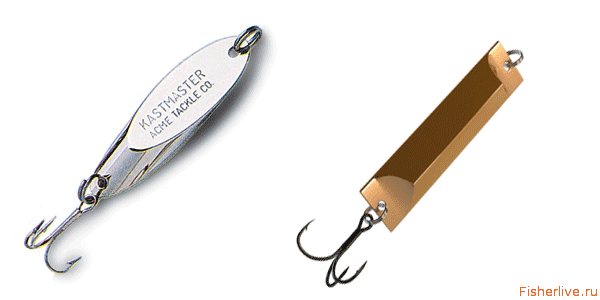
Unlike wobblers and spinners, these baits do not make unnecessary noise when splashing down, and very accurately fall into the right place.
Fishing with live bait
This method of fishing is no less effective than spinning, and does not contradict the spawning ban. As a tackle you need to use a float rod. Before spawning, long forms are not needed, they will only interfere with fishing and frighten the already timid asp. After spawning, you can take the usual Bolognese rod.
A regular mono line with a diameter of 0.2mm or more will do. The float should be invisible to the asp. Before spawning, you can use floats made of wine cork or foam plastic painted in dark colors. In this case, the sinkers should be placed directly under the float.
The installation of the equipment itself is no different from conventional float installation. First comes the float, under it is the sinker, and then the hook.
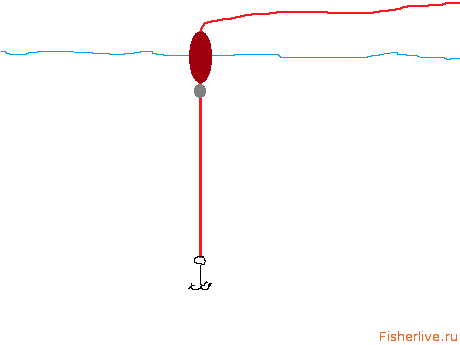
After spawning, when the asp is far from the shore, it is best to use a bombard float.
This float allows you to make long casts without using a sinker, which has a positive effect on the bite.
In this type of fishing, it is best to use treble hooks. Since our bait does not go along the bottom, the probability of a hook is very small, but the chances of being caught will increase.
The bombard rig works on the same principle, only without a sinker. In general, the bombard is designed as a sliding float, and this is not surprising, because it is intended for long casts. But in our case it is necessary to fix it with stoppers.
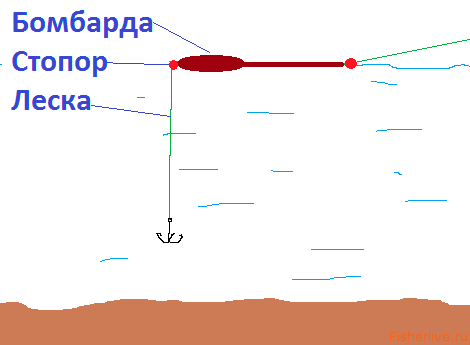
This way we can set the desired horizon for the bait, and will not allow the baitfish to go to depth.
Choosing a place and preparing for fishing
A light spinning rod with a small spinning reel, high boots (wading), several types of bait - the basic set for hunting sheresper .
You should look for fish close to the shore , where willows grow above the water, in half-bays, where the shore is steep, on sandy spits. The asp swims to such places to hunt, because small fish prefer to live here. Sheresper strives to quickly gain strength after winter ; in the spring he becomes, one might say, aggressive.
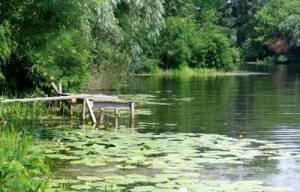
The asp, having chosen a place for its hunt , from time to time swims there from the depths, when the bleak concentrates in a flock, attacks and swims away again. Bleak cannot be called simple prey. One attempt to catch it, as a rule, is not enough; the voracious asp makes repeated skillful attacks .
Early in the morning, the sheresper waits in ambush, in the shade of coastal trees. He waits for his prey and approaches it quietly, slowly, and then attacks it with lightning speed.
The daytime asp hunt differs from the morning hunt. During the day, he attacks, swimming out of the pool, quickly finding himself in shallow water.
In the evening, slanting sunlight appears on the water surface. This is a good light for smallmouth hunting.
Tackle for asp
As for gear, for asp fishing they prefer to choose “fast” spinning rods with a length of 2.7-3 m with a test range of up to 40 g. This combination of characteristics allows you to make accurate long-distance casts, which largely determines the success of all fishing. It is advisable to select a reel with a large spool diameter. The gear ratio does not play a decisive role. And to save money, most anglers fish with standard ratio reels. The large diameter of the spool allows you to increase the casting distance and twist the line less. But the movement of the reel should be easy.
What to wind on the spool: monofilament or braid is a personal choice for the fisherman (a comparison of the two is here). But the fact that brightly colored fluorescent fishing line is much more convenient to use is an undeniable fact. When fishing on horseback, the movement of the bait with such a fishing line is much easier to control.
Tactics and fishing methods
First, let's talk about camouflage, because this is the key to a good catch. The angler must move smoothly and deliberately .
Bright colors of a fisherman's clothing can scare away the asp and make fishing fruitless.
Someone is trying to disguise themselves as a bush , sticking branches into their headdress and crawling along the shore. In fact, the fisherman's slow and careful movements are enough. The hunter's immobility and the sheresper's enthusiasm for chasing bait are excellent conditions.
Asp is a cunning opponent. This means that in order to catch him, you have to be even more cunning. By studying the behavior of the fish, you can predict what step will be next. The bait should be in the path of the sheresper . This predator loves to suddenly find itself in a school of bleak, slap the water with its tail, and suddenly turn around in place. This movement provokes the appearance of a funnel, disorienting the bleak.
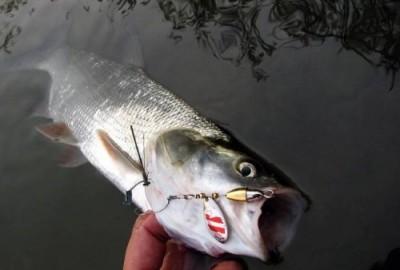
The moment the small change enters the asp's mouth is very important for the fisherman . Having tracked the sheresper's hunting location, the place of his first attack, the fisherman does most of the work.
Next, you need to choose a position lower in the current, wait until the asp makes the first blow, and at the same time throw a wobbler to the fish. The bait should be led downstream . Imagine that this is a small fish that is stunned and lost orientation in the water. The wobbler should swim jerkily . Such a fish will immediately attract the attention of the sheresper, because it is easier to catch.
Hooking is a delicate matter , haste can ruin everything. The moment when you need to hook is the feeling of the weight of the fish that grabbed the bait. A certain degree of composure is required here. However, self-cutting of a sheresper often happens when it tries to swim to depth.
The sound of the friction brake makes it clear to the asp that he is caught in a trap, and what he caught is inedible, in addition, it causes him pain, piercing his lip. Sheresper is desperately trying to free himself from his “prey”, but the monofilament does not allow him to do this. The sheresper's rampage begins: noise, splashes. Monofilament holds tightly, because it is quite elastic. The asp feels pain from the hook in his lip and tries to swim to the depths and free himself. But the brake does not allow the sheresper to do this. As a result, the asp ends up at the hunter’s feet.
Features of catching asp in spring
Jig is the best bait for early spring asp hunting. With success, sherespers are caught at this time using foam rubber. To fish with a good catch, you should wait for the asp’s first meal. It occurs after spawning, 1 - 2 weeks after it. This is approximately the end of March in the southern regions. In the north, it is recommended to start hunting for sheresper later.
In April

Fishing for asp in April using a spinning rod will delight you with a rich catch, since the higher the water temperature, the more active the asp is. Splashes of asp hunting on the rifts are observed more and more often every spring day.
At this time, the spoon should be moved slowly , sometimes submerging it to the middle of the water. At the end of April, there is a sharp decline in the sheresper biting. The reason is a rise in the water level, which during this period becomes very muddy.
In the central regions of Russia, sheresper spawning occurs at the end of April. 1.5 - 2 weeks after spawning, the asp becomes especially voracious. He hunts from dawn to dusk every day for about 10 days , and then switches to his standard diet - 5 meals a day.
In May
Asp is especially active in May in central Russia.
At this time, the weight of the sheresper varies from 0.5 to 10 kg .
Catching asp in May with a spinning rod from a boat is recommended only if there is drizzling rain or the wind creates ripples on the water.
This weakens the predator's vigilance.
If the weather is clear, it is better for the fisherman to position himself on the shore.
Asp is a fan of cooler water , so in May you should look for it where there is a strong current.
Catching Asp in the Spring. 5 Best Places. Tackle and Lures | Video
This fish is distinguished by enviable strength, cunning and endurance. A fisherman going to asp in the spring should know this. Catching asp in the spring, namely its success, depends to a decisive extent on knowledge of the habits of the fish, endurance and experience.
Detained poachers told the Secret of their success for a good bite. The fishery inspectors were surprised by the lack of Prohibited Equipment.
When to catch asp
Activity varies at different times of the year. From November to March it is impossible to get such a trophy. When the water cools, the asp goes into pools without a current, lays down on the bottom and hibernates. At this time, he does not feed, unless there is a sick fish nearby. Few masters can boast that they caught it in winter. If such cases do occur, more often in places where asp accumulate - due to the small amount of prey, the fish does not have time to build up its fat reserves for the winter and is forced to hunt to maintain life.
Having completed spawning in the spring, the asp actively gains weight and therefore eats a lot. Since the water has not yet warmed up to its full depth, it prefers to be in the upper layers or in shallow water. In April and May it feeds on fry. The first months of summer, June and July, are marked by the fact that this solitary fish gathers in schools. Observant spectators can see dozens of large asps rushing about in the backwaters, jumping out of the water, stunning small things in order to have time to eat more. Perhaps this is the most suitable time for catching a trophy specimen.
Those who wish to return with a catch in August and September should remember that serious changes occur in the behavior of fish. The predator has gained a lot of fat, so it does not grab any bait and becomes cautious. Flocks and even pairs break up, asps swim alone, looking for and catching up with the little things they like. In autumn, activity decreases; nothing can guarantee a good catch. You can only rely on luck, fishing experience and the mood of the future catch. When coastal ice sets in, dreams of catching an asp have to be put aside until next season.
Depending on the time of year, the specific fishing location and fishing habits, you can choose one of several tackles - fly fishing, spinning rod, float rod. Regardless of which gear you prefer, you need to know the subtleties to increase the likelihood of successful fishing.
Express tips for catching asp using a spinning rod in the spring
- The asp is a large, cautious predator that must be tracked in order to be caught. You need camouflage , slow and careful movements and a sufficient amount of composure so as not to rush into the hook.
- For catching asp in the spring with a spinning rod, a 3-meter rod is convenient .
- The asp quickly gets used to the bait, and it becomes uninteresting to him. Fishing stores have a huge range of baits for predatory fish. It is worth stocking up on several types: wobblers, jigs, wabs, etc.
- The fishing line should be shock-absorbing ; it’s better not to take a braided one. Asp are perfectly caught on monofilament .
In conclusion, a video about catching asp on small rivers in the spring.
Fishing Features
Catching asp in the spring has a number of features. For surface fishing, a sled is indispensable. The essence of their work is to push the equipment away with the current. By changing the tension of the fishing line, you can move the sled closer or further away, dragging the bait along with it.
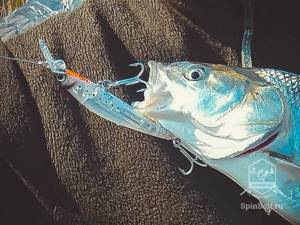
Is there a problem with the equipment? Don't despair! The predator can be caught using a slightly modified float rod. It is enough to move the sinker to the float or place the pellet above the bite alarm, and the float will lift the line above the surface of the water, and the hook with bait will not sink.
Often luck favors fly fishing enthusiasts who try to outwit the asp with streamers and wabs. Catching during a fight is considered especially effective. The cast should be made a couple of meters beyond the splash. In this case, the bait must be launched as softly and silently as possible. Make a stretch when the spoon is in the water. The bait, which has not had time to sink into the water column, should leave a clearly visible furrow. After moving the arm back as far as possible, the rod is carefully returned to its original position. The bite occurs precisely at this moment.
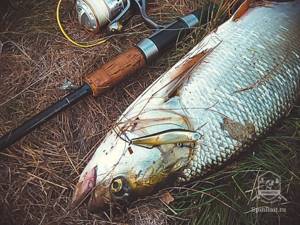
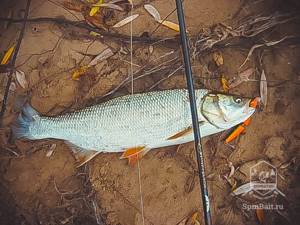
Remember about camouflage. This is important even if the distance to the fishing point exceeds 60 meters. Clothes should not rustle or creak, the color should be close to the natural environment. Control your movements. Sharp movements when catching a suspicious asp are unacceptable.
Catching asp in the spring is an unpredictable event. That is why, in the process of choosing effective fishing tactics, the fisherman is required not only to select competent gear and bait, but also to demonstrate ingenuity and observation. Only in this case can one dream of owning such a valuable trophy. Good luck!
Fishing tactics
Having discovered an asp in the spring by splashes or having chosen a place for its possible parking, you should cast it upstream. This is due to the biological feature of the behavior of fish in the current (as is known, it always stands with its head against the flow of water). And if you present the bait in this way, it will be detected much faster.
In order for an asp to peck in the spring, it is enough to make three to five postings. And if the cherished bite does not happen, then without regret you can move to another place.
You can write hymns about the asp bite. In terms of emotionality, she ranks first among others. The most powerful first blow always occurs unexpectedly. If you don't hold the rod tightly, there is a chance of dropping it. The crackling of the clutch, then powerful jerks upstream, and sometimes fountains of splashes accompany the entire process of fishing. It usually lasts several minutes. But at such moments, time seems to stop, and it seems like an eternity has passed, but this makes the trophy even more valuable.
